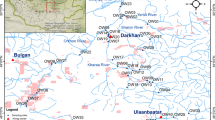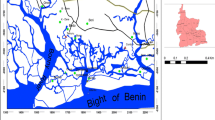Abstract
Water and sediment quality in threetidal bayous located near Pensacola, Florida, wereassessed during 1993–1995. The primary objective wasto determine the environmental condition of therelatively small urban bayous by comparing thechemical quality of the sediments and surface waterwith published guidelines and criteria developed toprotect marine life. Surface water concentrations ofmost potential toxicants such as heavy metals,organochloride pesticides, PAHs and PCBs were usuallybelow method detection limits. The major exception tothis trend was for copper which consistently exceededFlorida and National acute and chronic water qualitycriteria. Nickel, cadmium and chromium intermittentlyexceeded these criteria. Sediment contamination wassite-specific and chemically diverse. Theconcentrations of as many as 17 compounds exceededproposed Florida sediment quality assessmentguidelines indicating the potential for adversebiological effects. Nutrient concentrations, with oneexception, were below average levels found in otherFlorida estuaries. Seasonal variation in contaminantconcentrations for sediment collected from the samesampling station was less than an order of magnitude. The differences in the concentrations of the sameanalytes as measured for the multiple samplingstations located within the same bayou varied 1 to 2orders of magnitude and over 2 orders of magnitude forthe 20 sampling stations located in the three bayous. A within-bayou sediment contaminant gradient wasevident; sediment quality generally improved seaward.
Similar content being viewed by others
References
Anderson, J.W., Bay, S.M. and Thompson, B. E.: 1989, Characteristics and Effects of Contaminated Sediments from Southern California, in Oceans 89, IEEE Publication No. 89CH2780–5.
Chappie, D., Fuchsman, P., Barber, T., Warwick, C., Burris, J. and Field, J.: 1997, Graphical Deviation of Multiple Metal Populations in Sediment: Site-Specific Background, Society of Environmental Toxicology and Chemistry Annual Meeting (Poster), San Francisco, CA.
Cox, L. H. and Ross, N. P.: 1996, Statistical Issues in Environmental Monitoring and Assessment of Anthropogenic Pollution, U.S. Environmental Protection Agency, EPA/600/A-96/018, Research Triangle Park, NC.
Engle, D. and Evans, D.: 1997, Assessment of Contaminants in Sediments of the Coastal Gulf of Mexico and Potential for Impact on Living Marine Resources, NOAA, National Marine Fisheries Service, Beaufort, NC.
Florida Department of Environmental Regulation: 1993, Criteria for Surface Water Quality Classifications 17–302.530, Bureau of Surface Water Management, Tallahassee, FL.
Florida Department of Environmental Regulation: 1994, Approach to the Assessment of Sediment Quality in Florida Coastal Waters, Vol. 1. Development and Evaluation of Sediment Quality Assessment Guidelines, Prepared for FDEP, Office of Water Policy, Tallahassee, FL, by MacDonald Environmental Sciences Ltd., Ladysmith, British Columbia.
Florida Northwest Water Management District (FNWMD): 1991, The Pensacola Bay System-Biological Trends and Current Status, Water Resources Special Report 91–3, Havana, FL.
Friedemann, M. and Hand, J.: 1989, Typical Water Quality Values for Florida's Lakes, Streams and Estuaries, Florida Department of Environmental Regulation, Tallahassee, FL.
Hand, J., Col, J. and Lord, L.: 1996, Florida Water Quality Assessment: 1996, 305 (b) Technical Appendix, Bureau of Surface Water Management, Tallahassee, FL.
Hoffman, E. R., Anderson, S. L. and Knezovich, J. P.: 1994, Determinants of Sediment Toxicity in San Francisco Bay, LBL-36592, Report to U.S. Army Corps of Engineers. Available from Office of Scientific and Technical Information, Oak Ridge, TN.
Jones, W., James, P. E., Cason, J. and Bjorklund, P.: 1992, A Literature-Based Review of the Physical, Sedimentary, and Water Quality Aspects of the Pensacola Bay System, Florida Northwest Management District Water Resources Special Report 90–3.
Krantzberg, G. and Boyd, D.: 1992, Environ. Toxicol. Chem. 11, 1527.
Lewis, M. A., Weber, D. E. and Stanley, R.: 2000a, Arch. Environ. Contam. Toxicol. (in press).
Lewis, M. A., Weber, D. E., Stanley, R. and Albrecht, B.: 2000b, Environ. Toxicol. Chem. 19, 192.
Long, E. R., MacDonald, D. D., Smith, S. L. and Calder, F. D.: 1995, Environ. Manage. 19(1), 81.
Long, E. R., Field, L. J. and MacDonald, D.: 1998, Environ. Toxicol. Chem. 17, 714.
Long, E. R., Sloane, G., Carr, S., Scott, J., Thirsby, G., Grecelius, E., Peven, C., Windom, H., Smith, R. and Loganathon, B.: 1997, Magnitude and Extent of Sediment Toxicity in Four Bays of the Florida Panhandle: Pensacola, Choctawhatchee, St. Andrew and Apalachicola, NOAA Technical Memorandum NOS ORCA 117, Silver Springs, MD.
Macauley, J. M., Summers, J. K. and Engle, V. D.: 1999, ‘Estimating the Ecological Condition of the Estuaries of the Gulf of Mexico’, Environ. Monit. Assess. 57, 59–83.
McAfee, R. O.: 1984, Pensacola Bay Water Quality Monitoring Program: Review and Assessment, Escambia County Utilities Authority, Pensacola, FL.
Olinger, L. W., Rogers, R. G., Fore, P. L., Todd, R. L., Mullins, B. L., Bisterfeld, T. and Wise, L.: 1975, Environmental and Recovery Studies of Escambia Bay and the Pensacola Bay System, Florida, U.S. Environmental Protection Agency, Region IV, Atlanta, GA.
Seal, T. L., Calder, F. D., Sloane, G. M., Schropp, S. J. and Windom, H. L.: 1994, Florida Coastal Sediment Contaminants Atlas, Florida Department of Environmental Protection, Tallahassee, FL.
U.S. EPA: 1983, Methods for Chemical Analysis of Water and Wastes, Revised edition, EPA/600/4–79/020, Environmental Monitoring and Support Laboratory, Office of Research and Development, U.S. EPA, Cincinnati, OH.
U.S. EPA: 1986, Test Methods for Evaluating Solid Waste, Vol. 1A., Laboratory manual-physical/chemical methods, SW-846. Office of Solid Waste, Washington, DC.
U.S. EPA: 1994, Methods for Chemically Analyzing Marine Water, Sediments and Organisms, Gulf Ecology Division, Gulf Breeze, FL, SOP-043.
U.S. EPA: 1999, National Recommended Water Quality Criteria-Correction. EPA–822–7–99–001, Office of Water, Washington.
Velinsky, D. J., Wade, T. I., Schlekat, C. E., McGee, B. L. and Presley, B. J.: 1994, Estuaries 17, 305.
Zarbock, H.W., Janicki, A. J., Logan, D. T. and MacDonald, D. D.: 1996, An Assessment of Sediment Contamination in Tampa Bay, Florida, Using the Sediment Quality Triad Approach, Estuary Program, Tampa Bay National Estuary Program Technical Publications, #04–96.
Author information
Authors and Affiliations
Rights and permissions
About this article
Cite this article
Lewis, M.A., Moore, J.C., Goodman, L.R. et al. The Effects of Urbanization on the Chemical Quality of Three Tidal Bayous in the Gulf of Mexico. Water, Air, & Soil Pollution 127, 65–91 (2001). https://doi.org/10.1023/A:1005281430417
Issue Date:
DOI: https://doi.org/10.1023/A:1005281430417




